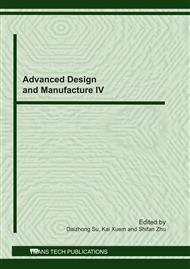p.73
p.77
p.81
p.87
p.91
p.95
p.99
p.103
p.107
The Investigation of Prediction Surface Roughness from Machining Forces in End Milling Processes
Abstract:
Surface roughness is one of the most significant parameters to determine quality of machined parts. Surface roughness is defined as a group of irregular waves in the surface, measured in micrometers (μm). Many investigations have been performed to verify the relationship between surface roughness and cutting parameters such as cutting speed, feed rate and depth of cut. To predict the surface produced by end milling, surface roughness models have been developed in this paper using the machining forces by assuming the end mill cutter as a cantilever beam rigidly or semi- rigidly supported by tool holder. An Aluminium workpiece and solid carbide end mill tools are used in this work. Model to predict surface roughness has been developed. Close relationship between machined surface roughness and roughness predicted using the measured forces signals.
Info:
Periodical:
Pages:
91-94
Citation:
Online since:
July 2011
Authors:
Price:
Сopyright:
© 2011 Trans Tech Publications Ltd. All Rights Reserved
Share:
Citation:


